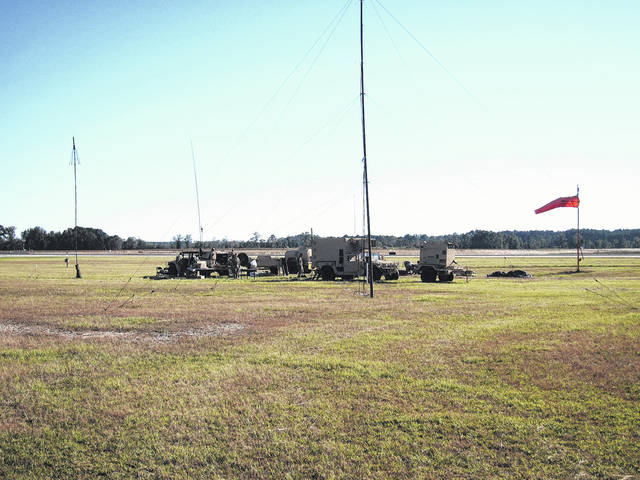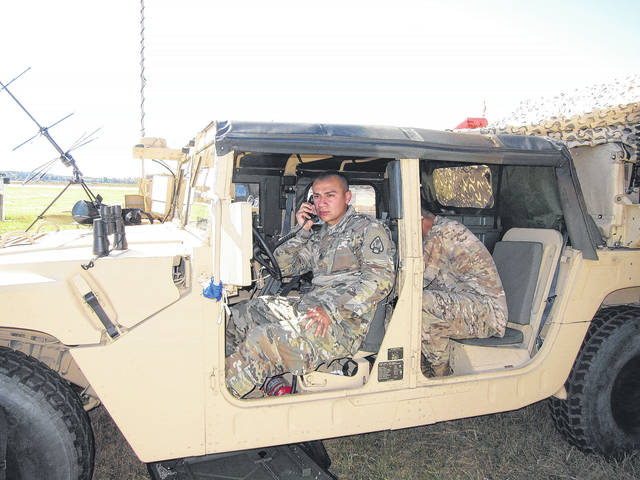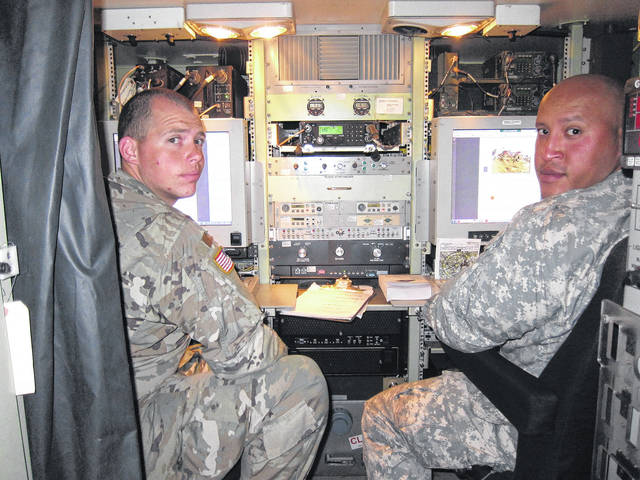LUMBERTON — Within five minutes of hitting the ground, members of the Army’s Unit 3-58 of the Airfield Operations Battalion can begin guiding landings and takeoffs of aircraft carrying critical personnel and supplies to a battlefield or to a natural disaster.
The Fort Bragg Army unit, with nine air traffic controllers, spent a week camped at the Lumberton Municipal Airport preparing for future missions. Training and organization are the lifeblood of the military, and this unit is organized down the the last detail —weapons placement, if needed.
The military exercise was a first for the Lumberton Airport and the first coordinated military exercise with the Laurinburg-Maxton Airbase since World War II, said airport Manager Troy Gammon.
“Our airport was taken over by the military during World War II,” Gammon said. “Gliders that lifted off from the Laurinburg-Maxton Airbase often landed here.”
Chief Warrant Officer Jason Christie gave a tour Thursday afternoon of the encampment, which includes sleeping quarters. They packed up and pulled out early Thursday morning.
“We’re blessed to have this facility nearby, because it is an uncontrolled airport, meaning they have no tower,” Christie said. “We come in and take over. Incoming aircraft are surprised to hear our voices.
“As a forward deployed unit, we come and set up after hurricanes, in war zones and for large events, such as the Boy Scout Jamboree this summer,” he said. “A unit like this was deployed to Puerto Rico after the hurricane.
“We prepared for Hurricane Irma, but it moved off,” Christie said.
Unit 3-58 is a mixed unit of veterans like Christie who has been deployed to Afghanistan and Kuwait, and younger soldiers. Despite sleeping in a tent at the Lumberton Regional Airport since last Thursday, they appeared well rested and alert.
The Civil Air Patrol, a volunteer organization, participates in the training exercise by guiding in additional aircraft to the site. They had two single-engine airplanes on site.
“Without the Civil Air Patrol, we wouldn’t get nearly as much traffic,” said Lt. Col. Tony Giordano. “They run scenarios with us, such as emergencies. They support us all the way.”
The air traffic control station is surprisingly compact, with one larger truck, a tent, a Humvee and a generator outside. Two air traffic controllers take shifts working around the clock in the Humvee, which gives them visibility.
An array of guyed antennas is set up outside. They include a VHF/UHF antenna for communicating with aircraft, a satellite communications antenna and a high-frequency antenna, that can send a signal up to 8,000 miles away.
All of it fits neatly inside a C-17 Globemaster, or a C-130 Hercules aircraft, or slung beneath a CH-47 Chinook helicopter. The 82nd Airborne is mobile and so are key support equipment and personnel like this.
Inside the truck is an array of instrumentation with two computer screens for following flights. Two more air traffic controllers are stationed there.
Inside the tent, more equipment, arms and uniforms are neatly laid out. A female soldier is eating, and it’s not an MRE, an acronym for meals ready to eat.
The training to become a certified air traffic controller is completed in 154 days or less through the Army, and, when completed, the personnel are certified by the Federal Aviation Administration or FAA. Many of these men and women will go to work at civilian airports around the nation.
On this afternoon, they give the OK for takeoff to three World War II training planes, which are part of the GIECO Skytypers airshow team. It might have been the highlight of this routine but important training mission.










